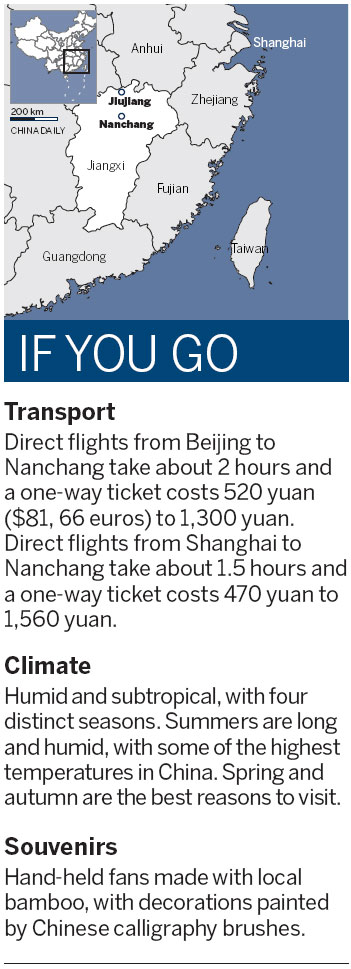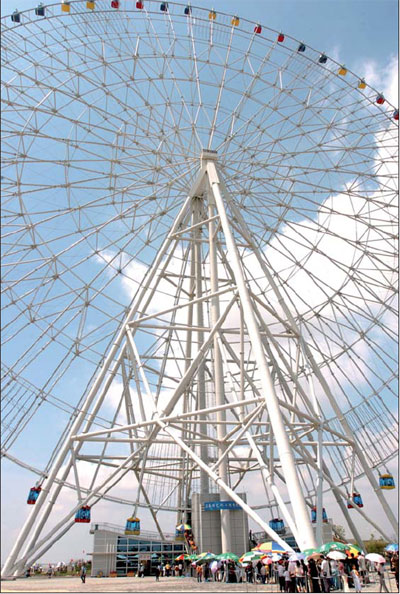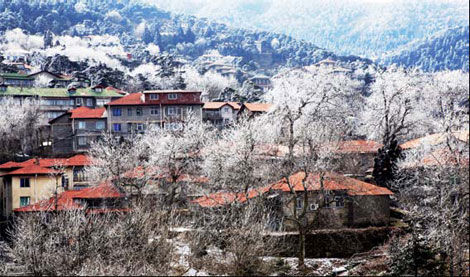Lofty Lushan Mountain
Temples in Hidden Places
On the First of August
Wheels by the Water
Share your travel story with regional@chinadaily.com.cn
Time to shine
( China Daily )
Updated: 2012-07-20
|
The Star of Nanchang is an icon of the city. Photos provided to China Daily |
|
Lushan consists of 99 individual peaks, with the tallest rising to nearly 1,500 meters. |
Revolutionary hub boasts historic pedigree, natural beauty
Despite its reputation as a cradle of Chinese revolution, Nanchang, the capital of East China's Jiangxi province, did not benefit much from its illustrious past. The Nanchang Uprising on Aug 1, 1927, which marked the birth of the People's Liberation Army, sealed the city as a heavyweight of wartime China.
But in modern China, Nanchang, compared to the more prosperous coastal cities, has been left behind during the country's swift economic growth. This was until late June, when the central government issued a document offering preferential policies to boost the development of old revolutionary bases in Jiangxi.
The long-awaited incentives target cities in south Jiangxi, but as the capital of the province, Nanchang with a population of 5.04 million, is destined to become the regional economic powerhouse and shoulder more responsibility for the further development of the area.
Business aside, Nanchang is famous for its scenery, rich history and cultural sites. The Ganjiang River passes through the city from south to north and the whole city is dotted with rivers and lakes. Its outskirts are surrounded by green mountains, and the stunning views of the city have inspired many talented poets since ancient times.
Visitors will still be able to get their fair share of beautiful scenery, history and culture on short or weekend trips to the city. Here are a few attractions to start with:
1. Tengwang Pavilion

Located on the shore of the Ganjiang River, Tengwang Pavilion is one of the three most notable pavilions in the southern, lower reaches of the Yangtze River. The others are Wuhan's Yellow Crane Tower in Hubei province and Yueyang Pavilion in Hunan province.
Tengwang Pavilion rose to fame mainly due to a classic piece by Tang Dynasty (AD 618-907) poet Wang Bo, who finished Preface to the Pavilion of Prince Teng after encountering a grand banquet held there. Standing 57.5 meters tall at nine stories, the pavilion is named after Li Yuanying, the younger brother of Tang Dynasty Emperor Taizong, 1,300 years ago.
The original Tang Dynasty pavilion was rebuilt 20 years after its completion and has been rebuilt 29 times over the course of its history. A theater within the modern pavilion, which was rebuilt between 1985 and 1989, stages musical performances. There is also a museum at a side entrance, where it is possible to see how the tower looked like during other eras.
2. Star of Nanchang (Ferris wheel)
Just like the London Eye, which stands 135 meters high on the south bank of the Thames, Nanchang also has its own giant wheel that offers breathtaking views on a single ride.
The Star of Nanchang, standing 160 meters tall, became one of the world's highest Ferris wheels after being put into operation in 2006. Located at the west side of the Ganjiang River, the Star of Nanchang has become an icon of the city. The wheel cost about 57 million yuan ($8.94 million, 7.28 million euros) to build. It has 60 enclosed air-conditioned gondolas, each carrying up to eight passengers, with a maximum capacity of 480 passengers. A single rotation takes about 30 minutes.
3. Jiangxi Provincial Museum
This museum, located 100 meters away from the Tengwang Pavilion, is a good place to understand the past of Jiangxi province. The museum is split into three buildings with three different themes: Jiangxi ancient civilization, Jiangxi revolutionary relics and the province's ancient ceramics.
The 13,000-square-meter museum boasts a collection of 34,000 items, ranging from ceramics to gold vessels, silverware, bronze, jade and ancient painting and calligraphy. The displays of the vast legacies of Chinese pottery stand out because of their relation to key kilns such as Porcelain Capital, Jingdezhen. There is also a good summary of the advanced technologies used.
4. Lushan National Park
Lushan National Park is a UNESCO World Heritage site. The park, located in nearby Jiujiang city, offers stunning views ranging from spectacular peaks, lakes, cliffs and waterfalls to important Buddhist and Taoist temples.
Lushan is known as one of the finest summer resorts in China and was used as the location for a famous Chinese film, Romance on Lushan Mountain. The mountain consists of 99 peaks, with the tallest rising to nearly 1,500 meters. The high-speed rail from Nanchang to Lushan cuts the traveling time to 45 minutes.
Eating and drinking
Nanchang is famous for its spicy dishes. Nanchang rice noodles, dressed with ginger, garlic, capsicum and pepper, is a must-try among various local street dishes in the city. Traditional snacks such as roubingtang or steamed pork with eggs, and waguantang, a special soup cooked in pottery jars, are also available throughout the city.
Rather than beers and wines, the drinking culture in Nanchang is more about enjoying a cup of fine Chinese tea. The history of tea drinking and teahouses in Nanchang can be traced back more than 1,000 years. There are about 20 modern teahouses in the city center. Gujin Chashi, located in No 129 Fuhe North Road, is suitable for first-time tea drinkers. Staff members have many years of experience serving Chinese tea.
China Daily
(China Daily 07/20/2012 page22)






